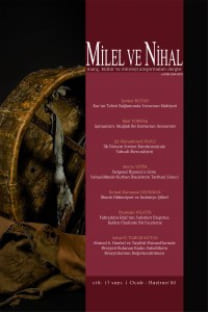Abdülkerim eş-Şehristânî'nin İslam Mezheplerini Tasnif Metodu
Çalışmamız, Şehristânî’nin İslam mezheplerini tasnifindeki metodu ve görüşlerinin tahlil ve tespitiyle sınırlıdır. Ancak onun mezhepler tarihi hakkındaki görüş ve yaklaşımlarını daha iyi değerlendirebilmek için yeri geldikçe tarihsel ve toplumsal arka plan hakkında da bilgi verilmiştir. Bu nedenle araştırmamızın temel kaynağını Şehristânî’nin İslam Mezhepleri tarihi ile ilgili olarak kaleme aldığı temel eseri el-Milel ve’n-Nihal oluşturdu. Söz konusu eserin İslam mezhepleri tarihindeki yeri, muhtevası ve önemi, mezhepleri tasnif metodu incelenirken yeri geldikçe verilmiştir. Bu meyanda İslam mezheplerinin genel tasnifi, Ehl-i Sünnet, Mürcie, Mu’tezile, Şia ve Havaric mezhepleri ve bunların alt fırkalarını ele alma biçimi, fırkaların sayıları değerlendirilmeye tabii tutulmuştur. Fakat burada bütün fırkaların ele alınmasından daha ziyade, araştırmamızın çerçevesini dikkate alarak bir sınırlamaya gidilmiştir. Bu bağlamda Şehristânî’nin İslam mezheplerini tasnifi, aynı zamanda onun metodu hakkında bilgi verdiği hatırlatılmıştır. Böylece onun hangi mezhebi niçin ele aldığı, varmak istediği sonuçlar, eleştirileri ve değerlendirmeleri gibi konular üzerinde durularak ana fikirleri takip edilmeye çalışılmıştır. Sonuçta ise varılan kanaatler özetlenmiştir.
Shahristani’s Methods on the Classification of Islamic Sects
The study consists of Shahristani’s methods on the classification of Islamic sects and analyses his ideas. It also gives information about historical and sociological background in order to evaluate the opinions on history of Islamic sects and the approaches properly. Therefore, the primary source of the study is al-Milal wa al-Nihal written by Shahristani dealing with History of Islamic Sects. The importance of the book in the genre and its content has been given in the place where the methods on classification of Islamic sects are studied. In this regard, his general classification of Islamic sects, namely Ahl Suna, Murjia, Mutazila, Shite and Hawarij and his manner of evaluation of sub-denomination, their numbers have been all investigated. However, the study has been restrictedly written for the reason of limited purpose, instead of working on all denominations. It has been also mentioned that the classification given by Shahristani indicates his method. By doing so, we easily found out the reason of why he presents specifically the certain sects, the conclusions, critiques, and the evaluations. In the conclusion the suggestions are summarized.
